Linden D., Reddy T.B. (eds.) Handbook of batteries
Подождите немного. Документ загружается.

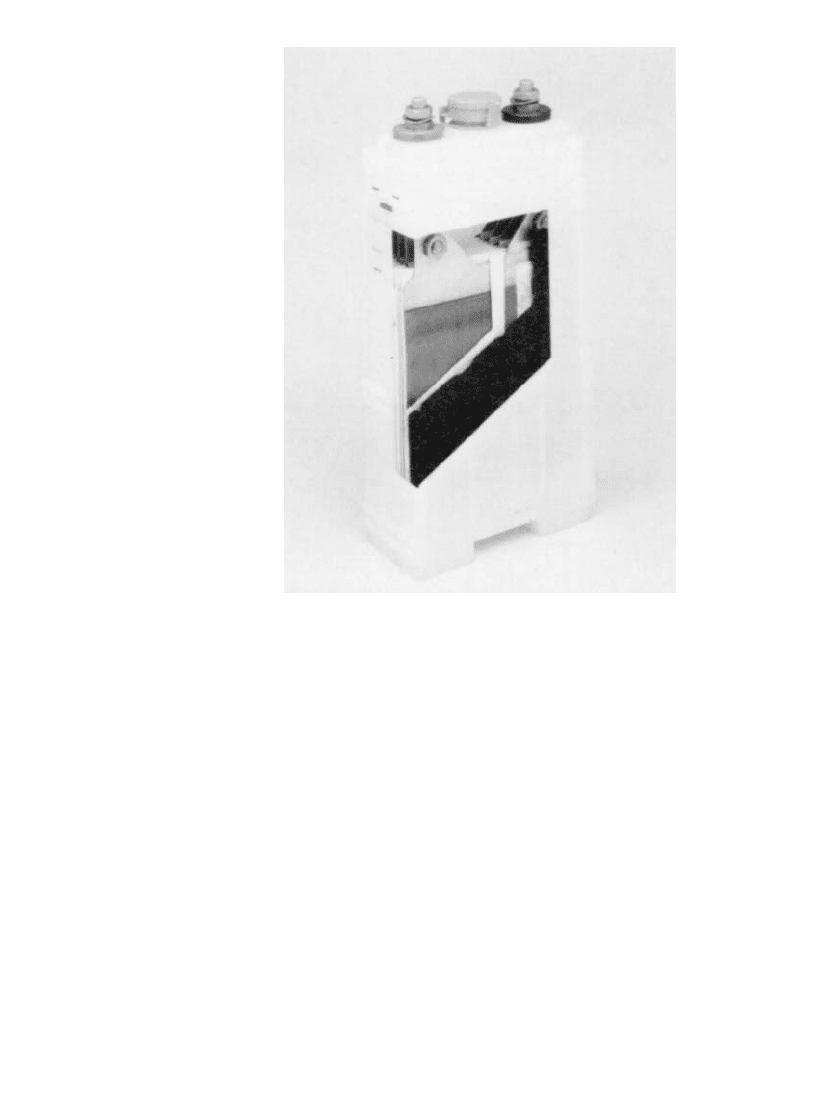
26.6 CHAPTER TWENTY-SIX
FIGURE 26.3 Plastic-bonded plate cell.
Figure 26.4 shows a partial cut-away view of a fiber nickel-cadmium (FNC) cell. The
case and cover are polypropylene and are welded together. The electrode assembly shows a
negative electrode, a corrugated separator and a positive electrode. O-ring seals are employed
in the bushings for the terminals to ensure gas retention and a vent valve is seen in the case
cover between the terminals. A catalytic gas recombination plug in the vent valve is em-
ployed for some applications. The terminals are nickel-plated copper, and a 1.19 kg/L KOH
electrolyte is typically employed.
Cells are assembled into batteries in many different ways. Often 2 to 10 cells are mounted
in a separate battery unit, several of which may be used to form the complete battery. A
typical battery is shown in Fig. 26.5. Cells in plastic containers are also assembled into
batteries by putting the single cells close together on a rack or a stand and connecting them
with intercell connectors. This is especially the case for stationary applications (Fig. 26.6).
Cells in steel containers can be assembled in a similar way; however, here the cells must be
spaced from one another and insulated from the rack.
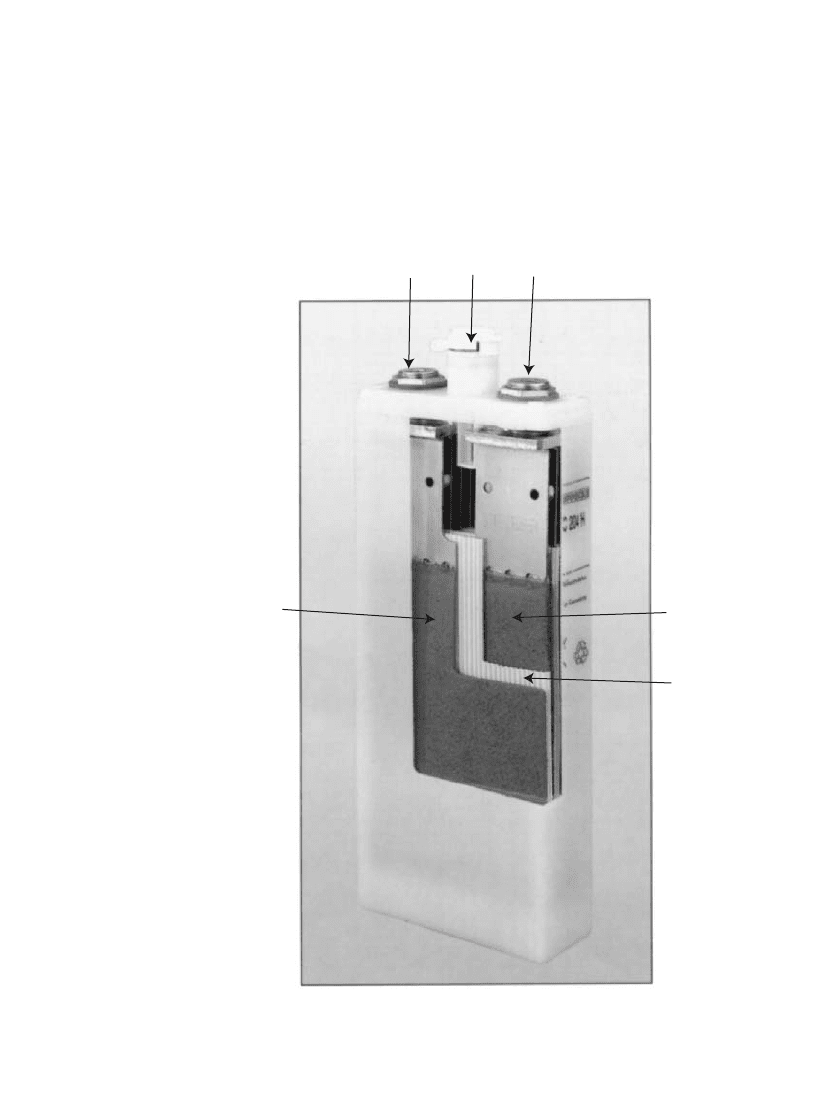
INDUSTRIAL AND AEROSPACE NICKEL-CADMIUM BATTERIES 26.7
Positive
Electrode
Separator
Negative
Electrode
Negative Terminal
Vent Valve
Positive Terminal
FIGURE 26.4 Partial cut-away view of fiber nickel-cadmium (FNC) cell. (Source: Hop-
pecke Batteries.)
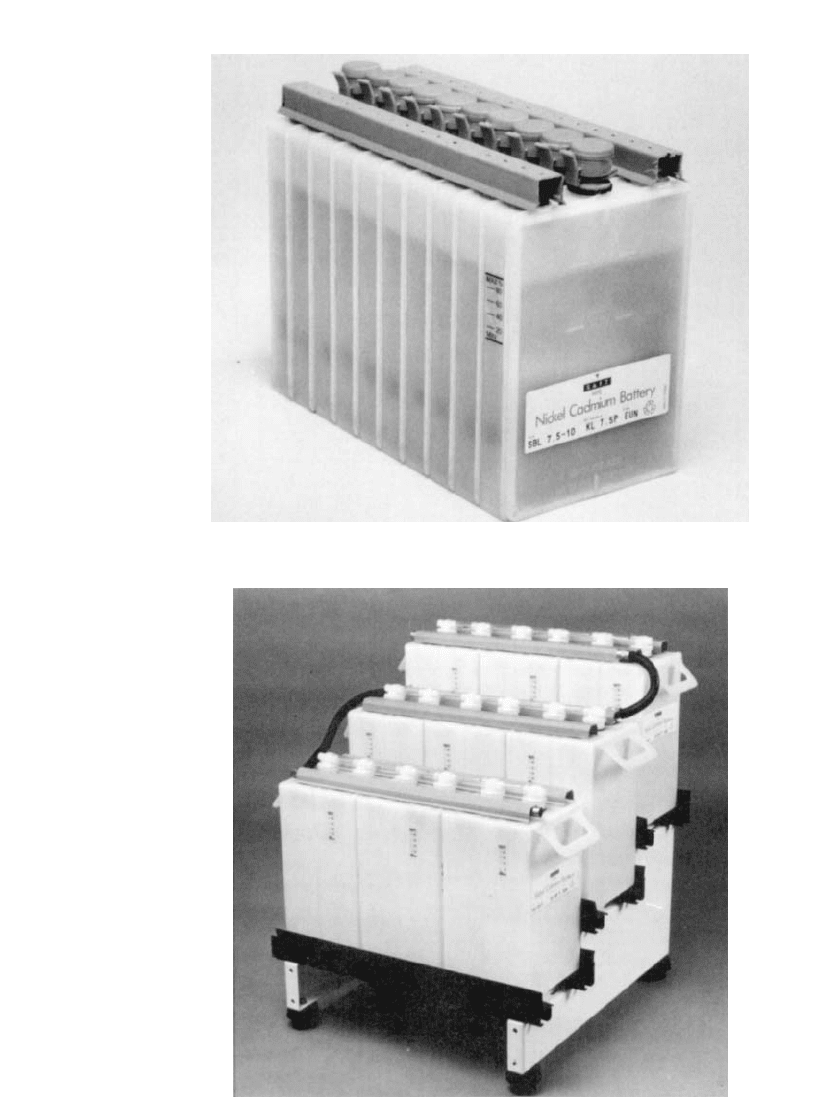
26.8 CHAPTER TWENTY-SIX
FIGURE 26.5 Ten-cell welded polypropylene unit.
FIGURE 26.6 Typical rack assembly of cells in plastic containers.

INDUSTRIAL AND AEROSPACE NICKEL-CADMIUM BATTERIES 26.9
26.4 PERFORMANCE CHARACTERISTICS
26.4.1 Energy Density and Specific Energy
Typical specific energy and energy density values for pocket plate single-cell batteries are
20 Wh/kg and 40 Wh /L, with the best values for commercially available units reaching 27
Wh/ kg and 55 Wh/L. The corresponding values for complete pocket plate batteries are 19
Wh/ kg and 32 Wh/ L and 27 Wh/ kg and 44 Wh/ L, respectively. These data are based on
the nominal capacity and the average discharge voltage at the 5-h rate. The specific energy
and energy density of larger fiber plate batteries approach 40 Wh /kg and 80 Wh /L. Batteries
with plastic-bonded plates approach 56 Wh/ kg and 110 Wh/L. This compares to a specific
energy of 30 to 37 Wh /kg and an energy density of 58 to 96 Wh /L for sintered-plate designs.
See Chap. 27.
26.4.2 Discharge Properties
The nominal voltage of a nickel-cadmium battery is 1.2 V. Although discharge rate and
temperature are of importance for the discharge characteristics of all electrochemical systems,
these parameters have a much smaller effect on the nickel-cadmium battery than on, for
instance, the lead-acid battery. Thus pocket plate nickel-cadmium batteries can be effectively
discharged at high discharge rates without losing much of the rated capacity. They can also
be operated over a wide temperature range.
Typical discharge curves at room temperature for pocket plate and plastic-bonded plate
batteries at various constant discharge rates are shown in Fig. 26.7. Even at a discharge
current as high as 5C (where C is the numerical value of the capacity in Ah), a high-rate
pocket plate battery can deliver 60% of the rated capacity and a plastic-bonded battery as
much as 80%. Battery capacities as a function of discharge rate and cutoff voltage are given
in Fig. 26.8.
Pocket-plate nickel-cadmium batteries can be used at temperatures down to
⫺20⬚C with
the standard electrolyte. Cells filled with a more concentrated electrolyte can be used down
to
⫺50⬚C. Figure 26.9 shows the effect of temperature on the relative performance of a
nickel-cadmium medium-rate battery with standard electrolyte.
Batteries can also be used at elevated temperatures. Although occasional operation at very
high temperatures is not detrimental, 45 to 50
⬚C is generally considered as the maximum
permissible temperature for extended periods of operation.
Figure 26.10 shows typical so-called starter curves for high-rate batteries. The batteries
can deliver as much current as 20C A during 1 s to a final voltage of 0.6 V.
Occasional overdischarge or reversal of nickel-cadmium batteries is not detrimental, nor
is complete freezing of the cells. After warming up, they will function normally again.
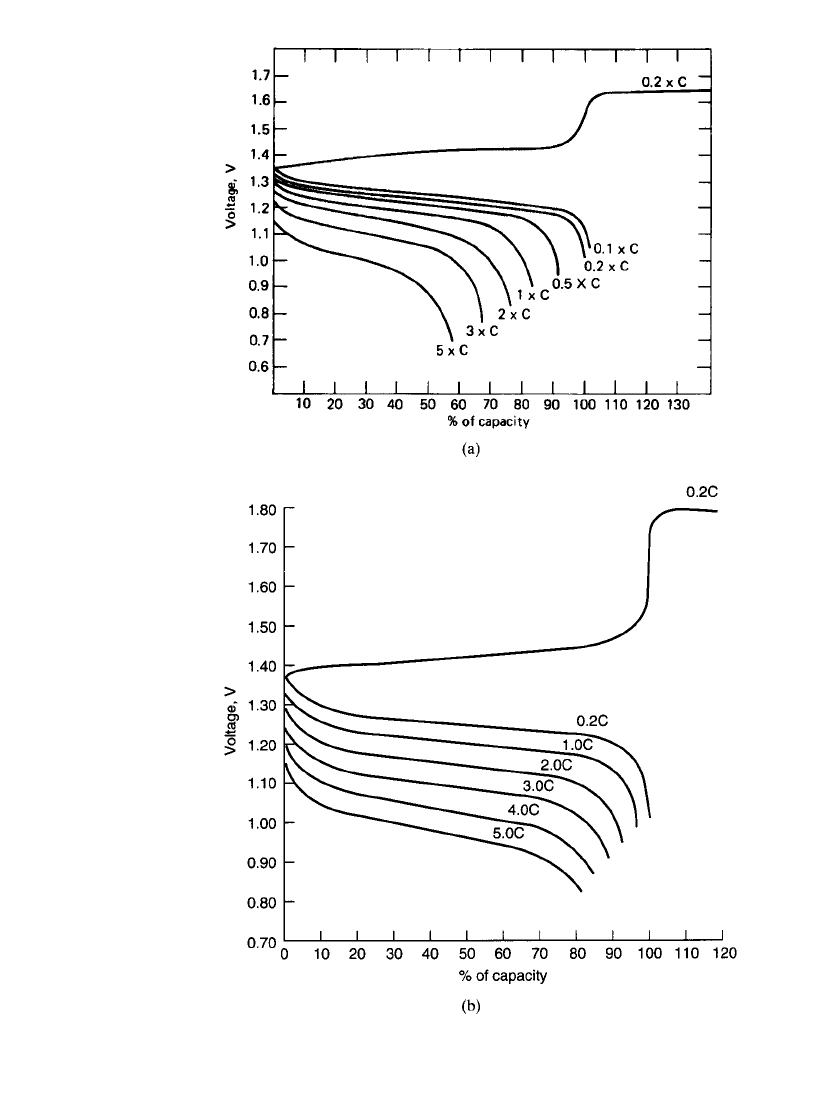
26.10 CHAPTER TWENTY-SIX
FIGURE 26.7 Charge and discharge characteristics of nickel-cadmium bat-
teries at 25⬚C. (a) Pocket plate battery, high rate. (b) Plastic-bonded plate bat-
tery, high rate.

INDUSTRIAL AND AEROSPACE NICKEL-CADMIUM BATTERIES 26.11
FIGURE 26.8 Discharge characterstics of nickel-cadmium batteries at 25⬚C; capacity as a function
of discharge rate and cutoff voltage. (a) Pocket plate battery, high rate. (b) Plastic-bonded plate
battery, high rate.
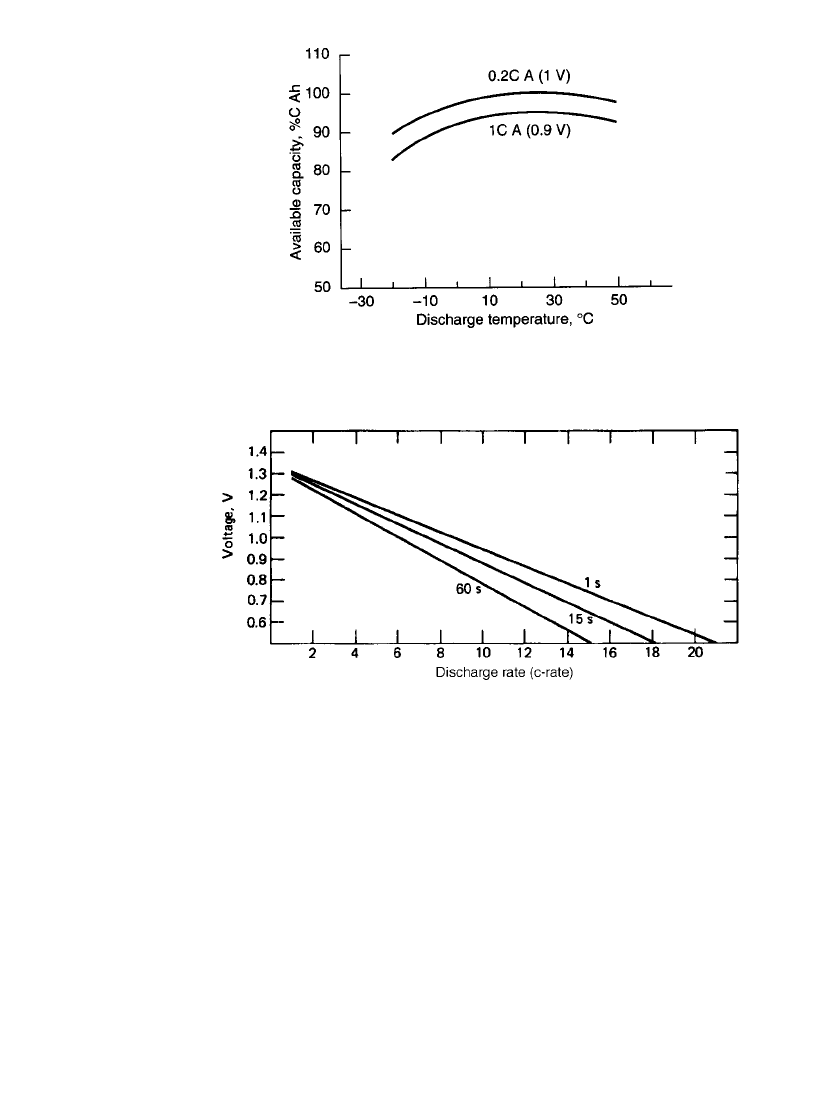
26.12 CHAPTER TWENTY-SIX
FIGURE 26.9 Typical available capacity at different
temperatures for nickel-cadmium medium-rate batteries
with standard electrolyte, fully charged at 25⬚c.
FIGURE 26.10 Voltage-current curves for high-rate pocket plate batteries at
25⬚C.
26.4.3 Internal Resistance
Nickel-cadmium batteries generally have a low internal resistance. Typical DC resistance
values are 0.4, 1, and 2 m
⍀, respectively, for a charged 100-Ah high-, medium-, and low-
rate pocket plate single-cell battery. The internal resistance is largely inversely proportional
to the battery size in a given series. Decreasing temperature and decreasing state of charge
of a battery will result in an increase of the internal resistance. The internal resistance of
fiber-plate batteries is 0.3 m
⍀ for a high-rate design and 0.9 m⍀ for a low-rate design.
Plastic-bonded plate batteries have an internal resistance as low as 0.15 m
⍀.
26.4.4 Charge Retention
Charge retention characteristics of vented pocket-plate batteries at 25⬚C are shown in Fig.
26.11. Charge retention is temperature-dependent, the capacity loss at 45
⬚C being about three
times higher than at 25
⬚C. There is virtually no self-discharge at temperatures lower than
⫺20⬚C. Charge retention for fiber and plastic-bonded plate batteries has similar character-
istics; their charge retention corresponds to that shown in Fig. 26.11 for high-rate batteries.
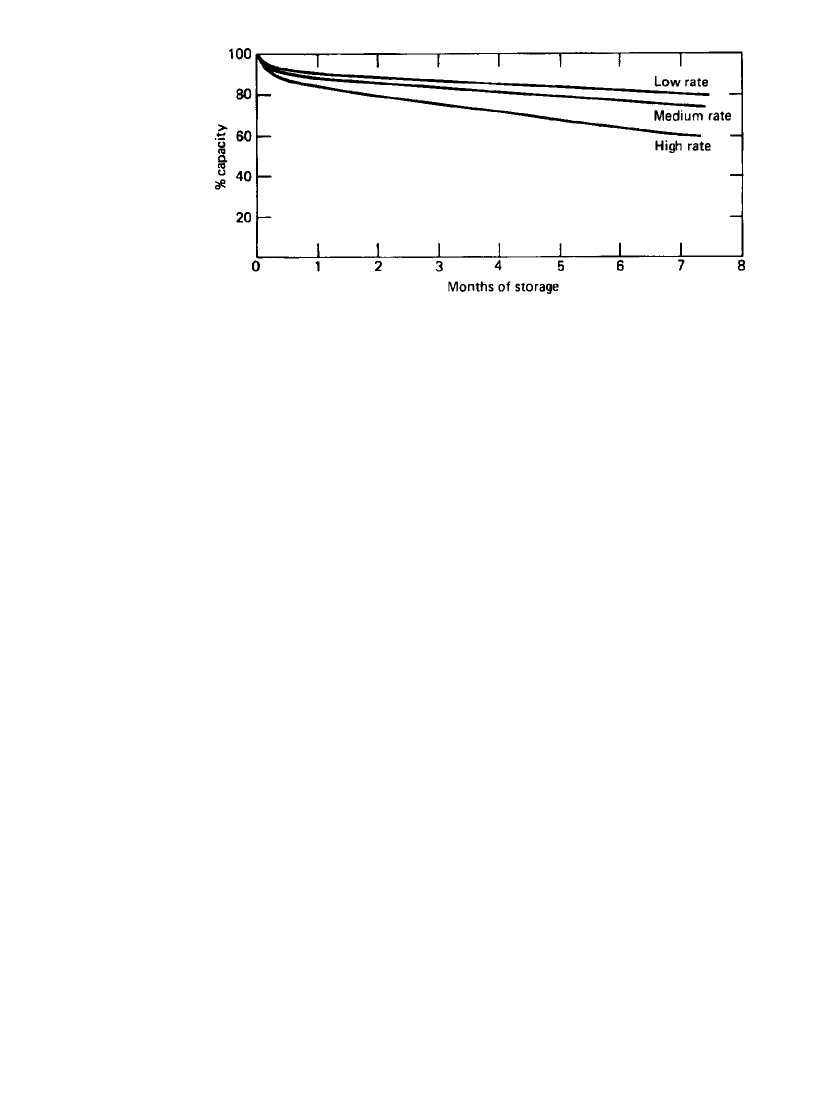
INDUSTRIAL AND AEROSPACE NICKEL-CADMIUM BATTERIES 26.13
FIGURE 26.11 Charge retention of pocket plate batteries at 25⬚C.
26.4.5 Life
The life of a battery can be given either as the number of charge and discharge cycles that
can be delivered or as the total lifetime in years. Under normal conditions a nickel-cadmium
battery can reach more than 2000 cycles. The total lifetime may vary between 8 and 25
years or more, depending on the design and application and on the operating conditions.
Batteries for diesel engine cranking normally last about 15 years, batteries for train lighting
have normal lives of 10 to 15 years, and stationary standby batteries have lives of 15 to 25
years.
Factors which affect the battery life are the operating temperature, the discharge depth,
and the charging regime. Low or moderate operating temperatures should always be pre-
ferred. Batteries operating at elevated temperatures or in cycling applications should be filled
with electrolyte to which lithium hydroxide has been added.
The factors behind the excellent reliability and very long life of the nickel-cadmium
batteries are the mechanically strong design, the absence of corrosive attack of the electrolyte
on the electrodes and other components in the cell, and, furthermore, the ability of the battery
to withstand electrical abuse such as reversal or overcharging and to stand long-time storage
in any state of charge.
26.4.6 Mechanical and Thermal Stability
Nickel-cadmium cells and batteries are mechanically very robust and can withstand severe
mechanical abuse and rough handling in general. The electrode groups are carefully bolted
or, in more recent designs such as FNC, welded together. The cell containers are made of
steel or high-impact plastics.
The electrolyte does not attack any of the components in the cell, and, accordingly, there
is no risk of decreased strength during the lifetime of the battery. Cases of so-called sudden
death due to corroded lugs or terminals cannot occur.
The thermal resistance of the nickel-cadmium batteries is also very good. These batteries
can withstand temperatures up to 70
⬚C or more without mechanical damage. Cells in poly-
propylene or steel containers are the best in this respect. Saline or corrosive environments
present no problems for cells in plastic containers.
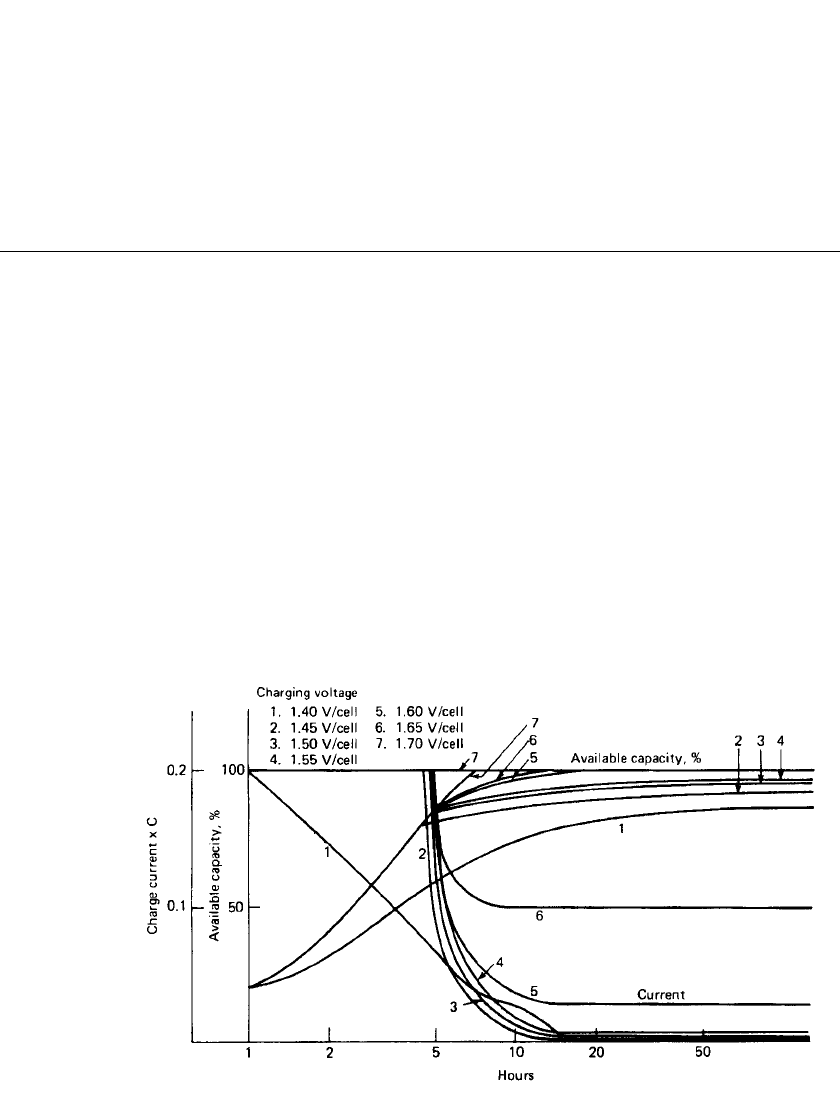
26.14 CHAPTER TWENTY-SIX
FIGURE 26.12 Constant-voltage charging with current limitation 0.2C of medium-rate pocket plate
batteries at 25⬚C.
26.4.7 Memory Effect
The memory effect—the tendency of a battery to adjust its electrical properties to a certain
duty cycle to which it has been subjected for an extended period of time—has been a problem
with nickel-cadmium batteries in some applications. Pocket, fiber, and plastic-bonded plate
cells do not show this tendency. See Sec. 27.7.2 for a description of the memory effect with
sintered-plate nickel-cadmium batteries.
26.5 CHARGING CHARACTERISTICS
Pocket-plate nickel-cadmium batteries may be charged at constant current, constant voltage,
or modified constant voltage. Constant-current charge characteristics are shown in Fig. 26.7.
Charging is normally carried out at the 5-h rate for 7 h for a fully discharged battery.
Overcharging is not detrimental but should be avoided as it leads to increased gassing and
decomposition of water. Charging can be carried out in the temperature range of
⫺50 to
45
⬚C. However, at the extreme temperatures, the charging efficiency is lower.
Constant-voltage charging characteristics with current limitations are shown in Fig. 26.12.
The current is often limited to 0.1 to 0.4C A, and charging is normally carried out in the
voltage range of 1.50 to 1.65 V per cell. The charging time may vary from 5 to more 25 h,
depending on current limitation value and cell type.
In some applications such as emergency and standby, it is necessary to keep the battery
in a high state of charge. A convenient way is to connect the battery in parallel with the
ordinary current source and the load and to float the battery at 1.40 to 1.45 V per cell. The
floating may be combined with a supplementary charge at fixed intervals or after each dis-
charge.
The Ampere-hour efficiency of the pocket plate battery is 72% when going from the
discharged to the fully charged state. The Watt-hour efficiency is approximately 60%. The
best plastic-bonded plate batteries have an Ampere-hour efficiency of 85% and a Watt-hour
efficiency of 73%.

INDUSTRIAL AND AEROSPACE NICKEL-CADMIUM BATTERIES 26.15
26.6 FIBER NICKEL-CADMIUM (FNC) BATTERY TECHNOLOGY
26.6.1 FNC Electrode Technology
An ideal electrode will feature the following characteristics:
•
Provide a high surface area conductive matrix to contact the active material
•
Provide sufficient porosity for high active material loading and an open structure for good
electrolyte penetration.
•
Have sufficient electrical conductivity to carry the current to the tab with minimal voltage
drop, yet will still be light
•
Fully contain the active material
•
Able to accommodate the dimensional changes during battery charge and discharge without
fatigue cracking
•
Tolerate mechanical shock and vibration
•
Chemically and thermally inert to the battery environment. Will not introduce any unde-
sirable impurities into the cell.
•
Utilize a simple process for the loading of the active material
•
Strong enough to tolerate the cell manufacturing processes
•
Versatile enough to allow manufacturing of various sizes, thickness, conductivity, and po-
rosity
•
Economical
It is in this area of plate design that the FNC technology has made a significant step
forward in comparison to older technologies. The core of the FNC technology is the three-
dimensional nickel-plated fiber matrix. The nickel coating is optimized to the expected cur-
rent density of the battery. Thus, there is no excess nickel. Electrodes of thickness ranging
from 0.5 to 10 mm targeted at ultra high (XX), high (X and H), medium (M), and low rate
(L) designs are fabricated in a common process. The nickel fibers are very compact with
one cubic centimeter of electrode volume nominally containing 300 meters of conducting
filament. This current collecting matrix is 90% porous, allowing excellent utilization of the
active material. The result is improved low temperature performance, a lower charge coef-
ficient, and significantly higher power capability (see Fig. 26.1a).
The structure is highly porous and thus allows for high loading of active materials as
well as excellent penetration of electrolyte. No conductive dilutents like graphite or iron are
required. Yet, due to the very high surface area of the fibers, the contact between the current
carrying fiber matrix and the paste is very good. Because of this, losses are low, resulting
in improved efficiency. The paste is loaded into the electrodes mechanically, and no impu-
rities are introduced in the process. Active material (nickel hydroxide in the positive plate
and cadmium hydroxide in the negative) is mechanically imbedded directly into the fiber
plate. The pure active material contributes to longer life, lower self discharge and a more
consistent and reliable product (see Fig. 26.1b). Consequently, a high surface area plate
capable of high current loads and very long life has been realized.
The processes and cell design associated with FNC technology have resulted in improved
battery performance. Improved charging efficiency has reduced the gassing on overcharge,
and with it, the frequency of water topping for the vented cells. The design of the FNC plate
allows elastic expansion and contraction during charge and discharge, eliminating one of the
main causes of nickel cadmium plate degradation. This plate flexibility also provides in-
creased shock and vibration tolerances. The flexibility of the electrode structure eliminates
mechanical cracks and associated plate degradation resulting in increased battery life.
